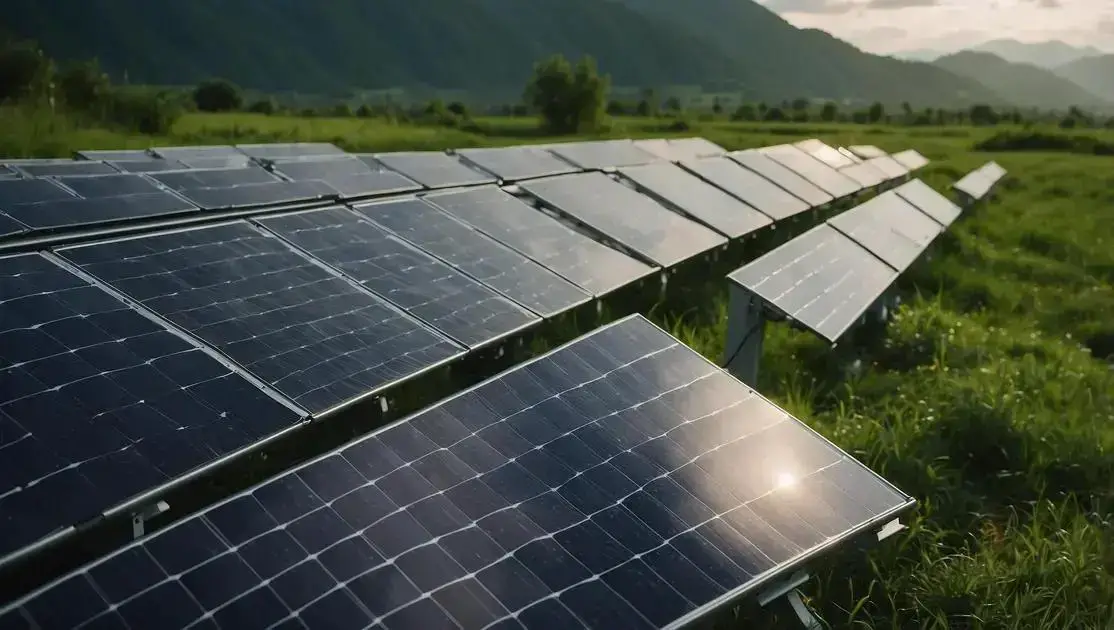Solar Dynamo technology is at the forefront of renewable energy innovation, revolutionizing how we harness the sun’s power. By employing advanced techniques, Solar Dynamo enhances energy efficiency and makes solar solutions accessible for everyone. As we confront climate change, the demand for sustainable energy sources grows, and Solar Dynamo is leading the charge towards a greener future. This article dives deep into the mechanics of Solar Dynamo, its numerous benefits, and how it compares to conventional power systems.
Table of Contents
ToggleUnderstanding the Solar Dynamo Concept
The Solar Dynamo concept revolves around harnessing and utilizing solar energy more efficiently than traditional methods. It combines innovative technologies with sustainable practices to maximize the power derived from sunlight. With increasing concerns over climate change and fossil fuel dependency, understanding how the Solar Dynamo works is crucial for energy consumers and producers alike.
What is a Solar Dynamo?
A Solar Dynamo is a system designed to convert sunlight into electricity using advanced solar panel technologies. Unlike standard solar panels, which primarily rely on photovoltaic cells, a Solar Dynamo integrates various techniques to enhance energy conversion and storage. This can include a combination of solar thermal and solar photovoltaic technologies.
How Does It Differ from Traditional Solar Systems?
Traditional solar systems mainly convert sunlight directly into electricity. In contrast, the Solar Dynamo also captures heat energy from the sun, transforming it into usable power. This dual energy capture allows for a more consistent and reliable power supply throughout the day.
Key Features of Solar Dynamo Technology
This technology is characterized by its versatility and efficiency. Advanced materials used in these systems can absorb a wider spectrum of sunlight, improving overall energy output. Additionally, smart grid integration allows for real-time monitoring and adjustment of energy flow, optimizing electricity use.
Importance of a Comprehensive Understanding
By understanding the Solar Dynamo concept, users can make informed decisions regarding their energy sources. This knowledge helps in selecting the best systems for residential or commercial use, ensuring maximum efficiency and sustainability. As solar technology evolves, keeping up with innovations like the Solar Dynamo becomes essential for anyone looking to invest in renewable energy.
Benefits of Solar Energy
The use of solar energy brings many advantages that make it a preferred choice for powering homes and businesses. First, solar energy is a renewable resource. This means it is abundant and won’t run out as long as the sun shines, making it a sustainable energy option for the future.
Environmental Benefits
Solar energy significantly reduces greenhouse gas emissions. By harnessing the sun’s power, we can lower our reliance on fossil fuels, which contribute to air pollution and climate change. Transitioning to solar energy helps protect our planet’s ecosystem.
Cost Savings
Another benefit of solar energy is the potential for significant cost savings over time. Once installed, solar panels can drastically reduce electricity bills. Many homeowners and businesses find that their investment pays off in just a few years through lower energy costs.
Energy Independence
Using solar energy can provide greater energy independence. By producing your own electricity, you are less affected by energy price fluctuations and can have more control over your energy supply. This is especially beneficial in regions with unstable energy prices.
Job Creation
The solar industry is rapidly growing, which leads to the creation of new jobs. From manufacturing and installation to maintenance, investing in solar technology contributes to job growth in local economies, offering numerous opportunities for skilled workers.
Increased Property Value
Homes equipped with solar panels often have higher property values. Many buyers are willing to pay a premium for homes that provide energy efficiency and lower electricity bills. This trend increases demand for solar-equipped properties in the housing market.
How Solar Dynamo Works
The Solar Dynamo operates through a combination of advanced technologies to maximize the capture and conversion of solar energy. At its core, this system uses photovoltaic cells to convert sunlight into electricity.
Photovoltaic Conversion
When sunlight hits the photovoltaic cells, it energizes electrons in the material, creating an electrical current. This process is called the photovoltaic effect. The electricity generated can be used immediately or stored in batteries for later use.
Thermal Energy Collection
In addition to photovoltaic technology, the Solar Dynamo captures thermal energy using solar thermal collectors. These collectors absorb sunlight and convert it into heat, which can then be used to produce steam. This steam drives turbines to generate additional electricity.
Smart Inverters
Smart inverters are essential components of the Solar Dynamo. They convert the direct current (DC) produced by solar panels into alternating current (AC), which is the form of electricity used in most homes and businesses. Smart inverters also help monitor the system’s energy production in real-time.
Energy Storage Solutions
Energy storage systems are vital for ensuring a consistent power supply, especially at night or during cloudy days. The Solar Dynamo includes high-capacity batteries that store excess energy generated during peak sunlight hours. This stored energy can be used when solar production is low.
Integration with Smart Grids
Finally, the Solar Dynamo works seamlessly with smart grids. It allows for efficient energy distribution and usage tracking. Home and business owners can manage their energy consumption and tap into the grid when necessary, optimizing their energy use and reducing waste.
Applications of Solar Dynamo
The Solar Dynamo has a wide range of applications that can significantly enhance energy efficiency and sustainability in various sectors. Its innovative technology allows for versatile uses in different settings.
Residential Energy Generation
One of the primary applications of Solar Dynamo is in homes. By installing solar panels, homeowners can generate clean energy for daily use. This decreases reliance on electricity from the grid and lowers energy bills.
Commercial Energy Solutions
Businesses can also benefit from Solar Dynamo technology. By implementing solar energy systems, companies can reduce operating costs, achieve energy independence, and showcase their commitment to sustainability, which can enhance brand reputation.
Remote and Off-Grid Power Supply
In remote locations, where access to traditional power sources is limited, Solar Dynamo provides an excellent solution. It can power homes, schools, and clinics in off-grid areas, offering essential services and improving quality of life.
Electric Vehicle Charging Stations
As electric vehicles (EVs) become more popular, Solar Dynamo can be integrated into EV charging stations. These systems can utilize solar energy to power charging infrastructures, promoting cleaner transportation options and reducing the carbon footprint.
Agricultural Applications
Agriculture can also benefit from Solar Dynamo systems. Farmers can use solar energy to power irrigation systems, greenhouses, and machinery, enhancing productivity while minimizing environmental impact.
Public Infrastructure and Street Lighting
Solar Dynamo technology can be employed for public infrastructure. Solar-powered street lights and traffic signals reduce electricity costs for municipalities and promote energy efficiency in urban planning.
Potential for Disaster Relief
In times of disaster, Solar Dynamo can provide quick and reliable energy solutions for shelters and relief operations. Portable solar units can be installed rapidly to support critical infrastructure and displaced individuals.
Solar Dynamo vs Traditional Power Sources
When comparing Solar Dynamo systems to traditional power sources, several key factors come into play. Understanding these differences is essential for choosing the best energy solution for homes and businesses.
Environmental Impact
Solar Dynamo relies on renewable energy from the sun, which means it generates no harmful emissions during operation. In contrast, traditional power sources, such as coal, natural gas, and oil, release greenhouse gases that contribute to climate change and air pollution. Switching to solar energy helps protect the environment.
Energy Cost
Solar energy can significantly reduce electricity bills. After the initial installation cost, the ongoing energy expenses tend to be much lower because sunlight is free. Traditional power sources, however, are subject to fluctuating market prices, which can lead to unpredictable monthly costs for consumers.
Reliability and Availability
Traditional power sources generally provide a stable and continuous energy supply, as they do not rely on weather conditions. Solar Dynamo, while highly efficient during sunny days, may produce less energy on cloudy days or at night. However, advancements in energy storage technology are improving solar energy’s reliability and allowing consumers to store excess power for later use.
Maintenance and Lifespan
Solar Dynamo systems require minimal maintenance compared to traditional power plants. Solar panels typically have long lifespans of 25 years or more, and frequent checks are often enough to keep them functioning efficiently. In contrast, traditional power plants may require significant maintenance and upgrades over time, leading to higher operational costs.
Energy Independence
Using Solar Dynamo allows individuals and businesses to generate their own electricity, which promotes energy independence. This reduces reliance on centralized power grids and decreases vulnerability to energy price hikes or supply shortages. On the other hand, traditional power sources often tie consumers to large utility companies.
Government Incentives
Many governments offer incentives for adopting solar energy, such as tax credits, rebates, and grants. These financial incentives can make the switch to Solar Dynamo more affordable. Traditional energy sources typically do not receive similar support, making solar options not only environmentally friendly but also economically attractive.
Innovations in Solar Technology
Innovations in solar technology are driving the energy sector forward, showcasing new methods to harness the sun’s power more effectively and efficiently. These advancements make solar energy a more attractive option for homes and businesses alike.
Improved Photovoltaic Cells
Recent developments in photovoltaic (PV) cell technology have led to higher efficiency rates. These advanced cells can convert more sunlight into electricity even in low-light conditions. Technologies such as bifacial solar panels capture sunlight from both sides, increasing energy output.
Perovskite Solar Cells
Perovskite solar cells are an exciting innovation that offers the potential for lower production costs while maintaining high efficiency. These cells are made from a variety of materials, making them versatile and adaptable for different applications. Research is ongoing to enhance their durability and stability.
Solar Tracking Systems
Solar tracking systems are another breakthrough technology. These systems adjust the angle of solar panels throughout the day so that they continuously face the sun. This increases energy capture by up to 25%, making solar installations even more efficient.
Energy Storage Advances
Energy storage solutions have also seen significant innovation. New battery technologies, such as lithium-sulfur batteries, provide greater energy density and longer lifespans. This allows users to store excess solar energy generated during the day for use during nighttime or cloudy periods.
Smart Solar Inverters
Smart solar inverters enhance the functionality of solar energy systems. They allow for real-time monitoring and optimization of energy production and consumption. These inverters can connect to smart home systems, enabling dynamic energy management and improved efficiency.
Building-Integrated Photovoltaics (BIPV)
BIPV technology integrates solar panels into the building’s architecture, such as windows, roofs, and walls. This approach reduces the need for additional space for solar installations and enhances the aesthetic appeal of solar energy systems.
Hydroponics and Solar Energy
Innovations are now exploring the combination of solar energy with hydroponic systems. Farming operations can utilize solar technology to power irrigation and climate control systems, improving sustainability in agriculture while reducing energy costs.
How to Choose a Solar Dynamo System
Choosing the right Solar Dynamo system can seem overwhelming, but by breaking it down into key factors, you can make an informed decision. Here are several important considerations to help guide your selection.
1. Assess Your Energy Needs
Start by evaluating your energy consumption. Look at your past electricity bills to determine how much energy you use on average. This will help you estimate the size of the system you need for your home or business.
2. Consider System Type
There are various types of Solar Dynamo systems to choose from, including grid-tied, off-grid, and hybrid systems. A grid-tied system connects to the utility grid, allowing you to sell excess energy. Off-grid systems are more independent, using battery storage to store energy for use when solar production is low. Hybrid systems combine both approaches.
3. Evaluate Solar Panel Efficiency
Not all solar panels are created equal. Investigate the efficiency ratings of different panels. Higher efficiency means more energy generation within the same space, which is important if you have limited roof space.
4. Check the Warranty and Lifespan
Look for systems that come with solid warranties. Most reputable solar panels have warranties ranging from 25 years. This ensures that you are covered if something goes wrong or if the panels degrade faster than expected.
5. Research Installation Costs
Installation costs can vary significantly. Get quotes from multiple installers and inquire about any additional costs, including permits or inspections. Investing in quality installation can make a significant difference in the system’s performance.
6. Look for Incentives and Financing Options
Check for federal, state, and local incentives for solar energy systems. Many regions offer tax credits, rebates, or grants that can lower your overall costs. Additionally, explore financing options that may help spread out the initial investment.
7. Review Company Reputation
Research the reputation of the solar provider. Look for customer reviews, industry certifications, and how long they have been in business. A reputable company should have strong customer service and support.
8. Plan for Future Expansion
If you plan to increase your energy usage in the future, consider choosing a system that can be expanded. This allows you to add more panels or storage capacity down the line without needing a complete overhaul.
Cost Analysis of Solar Dynamo Systems
Understanding the cost analysis of Solar Dynamo systems is essential for making an informed decision about investing in solar energy. There are several key components to consider, which can vary widely depending on your specific needs and location.
1. Upfront Costs
The initial costs of purchasing and installing a Solar Dynamo system can be significant. This includes the price of solar panels, inverters, mounting equipment, and batteries for energy storage. The average installation cost for solar systems can range from $15,000 to $30,000 or more depending on the size and specifications.
2. Installation Expenses
Besides equipment costs, installation fees play a crucial role in the total investment. Installation can account for 10% to 20% of the overall system cost. Factors influencing installation costs include the complexity of the installation and your roof’s structure.
3. Maintenance Costs
While Solar Dynamo systems require low maintenance, occasional checks and cleaning are necessary to keep them functioning effectively. Maintenance costs might range from $100 to $300 annually, depending on your system size and local service rates.
4. Incentives and Tax Credits
Various federal, state, and local incentives can significantly reduce the overall cost. Many regions offer tax credits, rebates, and grants that can lower your upfront expenses by 20% or more. It’s essential to research available incentives in your location to maximize savings.
5. Energy Savings
One of the biggest financial benefits of a Solar Dynamo system is the potential savings on your energy bills. Depending on your energy consumption and local electricity rates, you might save thousands of dollars over the system’s lifetime. Studies suggest homeowners can save $30,000 or more in energy costs over 20 years.
6. Payback Period
The payback period is the time required to recoup your initial investment through energy savings. On average, this period ranges from 5 to 10 years, depending on various factors, including the system size, local energy rates, and usage patterns.
7. Financing Options
Many financing options are available for those considering a Solar Dynamo system. From home equity loans and solar leases to power purchase agreements (PPAs), it’s important to explore different financing methods to find one that fits your budget and circumstances.
8. Long-Term Value
Investing in a Solar Dynamo system can increase your property value. Homes with solar systems often sell at a premium compared to those without. Additionally, solar systems typically have a lifespan of 25 years or more, offering long-term benefits and sustainability.
Future Trends in Solar Energy
The future trends in solar energy are exciting and indicate a major shift toward cleaner, more efficient energy sources. Here are some key developments to watch for in the coming years.
1. Enhanced Solar Technologies
Advancements in solar cell technologies, such as bifacial and perovskite solar cells, are expected to lead to higher efficiency and lower production costs. These innovations will make solar energy more accessible for homeowners and businesses.
2. Energy Storage Breakthroughs
As the need for reliable energy storage grows, research into new battery technologies continues. Innovations such as solid-state batteries and improved lithium-ion batteries allow for more efficient energy storage, making solar systems even more viable for off-grid and backup applications.
3. Smart Energy Management
Integration with smart technologies will play a crucial role in solar energy. Energy management systems that use artificial intelligence will analyze consumption patterns and optimize energy use, allowing users to maximize their savings and sustainability.
4. Community Solar Projects
Community solar initiatives are gaining traction, allowing individuals to invest in shared solar projects. This enables people who may not have suitable roofs for solar panels to benefit from renewable energy, encouraging wider adoption across various demographics.
5. Solar-Powered Transportation
The rise of electric vehicles is paving the way for solar integration in transportation. Solar-powered charging stations will become more prevalent, creating a greener transportation network powered by renewable energy.
6. Decentralized Energy Grids
Future energy systems are moving toward decentralized power generation. By allowing localized energy generation from solar installations, communities can enhance resilience and energy independence while reducing transmission losses.
7. Integration with Smart Cities
As cities evolve into smart cities, solar energy will become a vital component. Solar panels can be integrated into infrastructure, streetlights, and public transportation systems, leading to cleaner urban environments.
8. Increased Government Support
With climate change becoming a pressing issue, government policies and incentives are likely to shift more in favor of solar energy adoption. Expect more ambitious goals for renewable energy, including increased investments and funding for solar projects.
In conclusion, the future of solar energy is bright
As the world continues to move towards sustainable energy sources, the advantages offered by Solar Dynamo systems are becoming increasingly clear. From innovations in energy storage to efficiency improvements, these technologies are paving the way for a greener future.
FAQ – Frequently Asked Questions about Solar Dynamo
What is a Solar Dynamo system?
A Solar Dynamo system is an advanced solar energy solution that uses various technologies to efficiently capture and convert sunlight into electricity.
What are the benefits of using solar energy?
Solar energy reduces electricity bills, lowers environmental impact, provides energy independence, and can increase property value.
How much does a Solar Dynamo system cost?
The total cost can range from $15,000 to $30,000 or more, depending on the size and specifications of the system, including installation fees.
What incentives are available for solar energy?
Many governments offer tax credits, rebates, and grants that can significantly reduce the upfront costs of solar energy systems.
How do I choose the right Solar Dynamo system for my needs?
Evaluate your energy needs, consider system types (grid-tied, off-grid, hybrid), check panel efficiency, and explore financing options.
What is the payback period for a solar energy investment?
The payback period typically ranges from 5 to 10 years, depending on factors like the system size and local energy rates.











